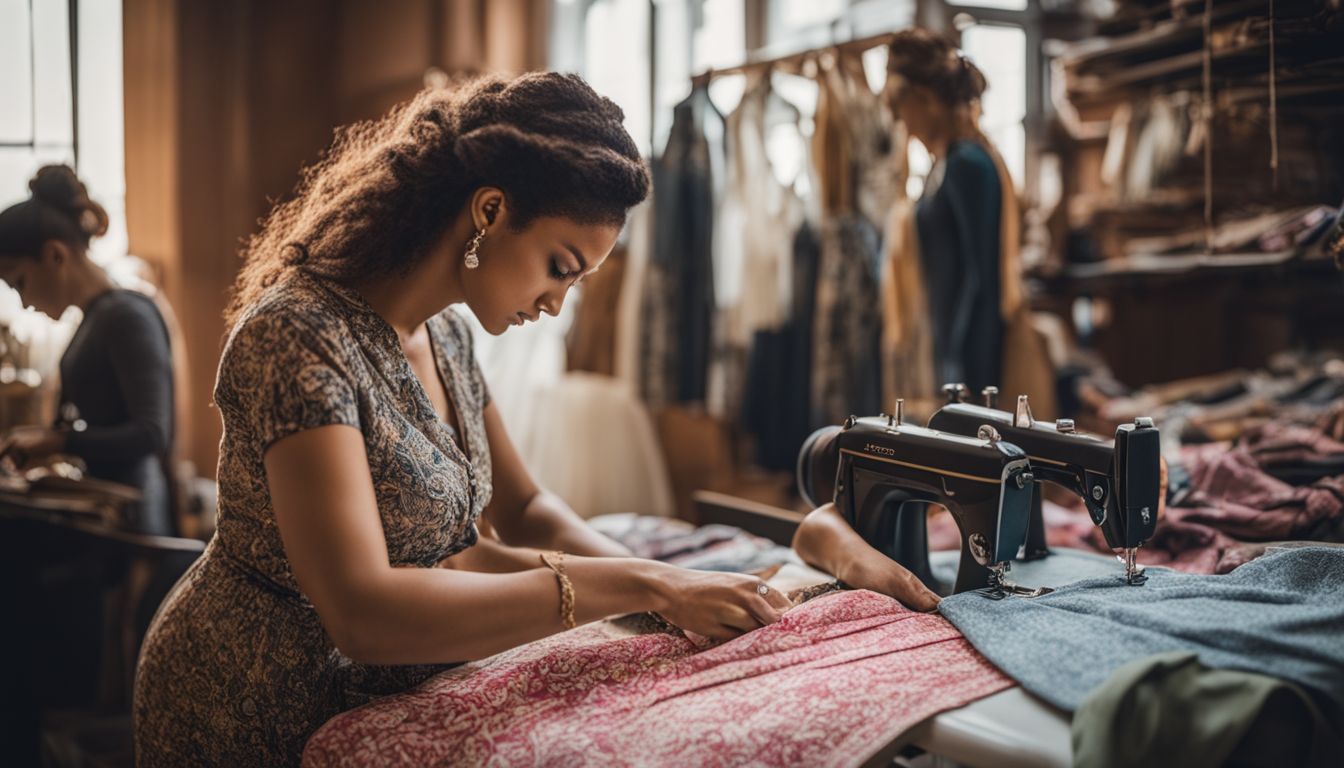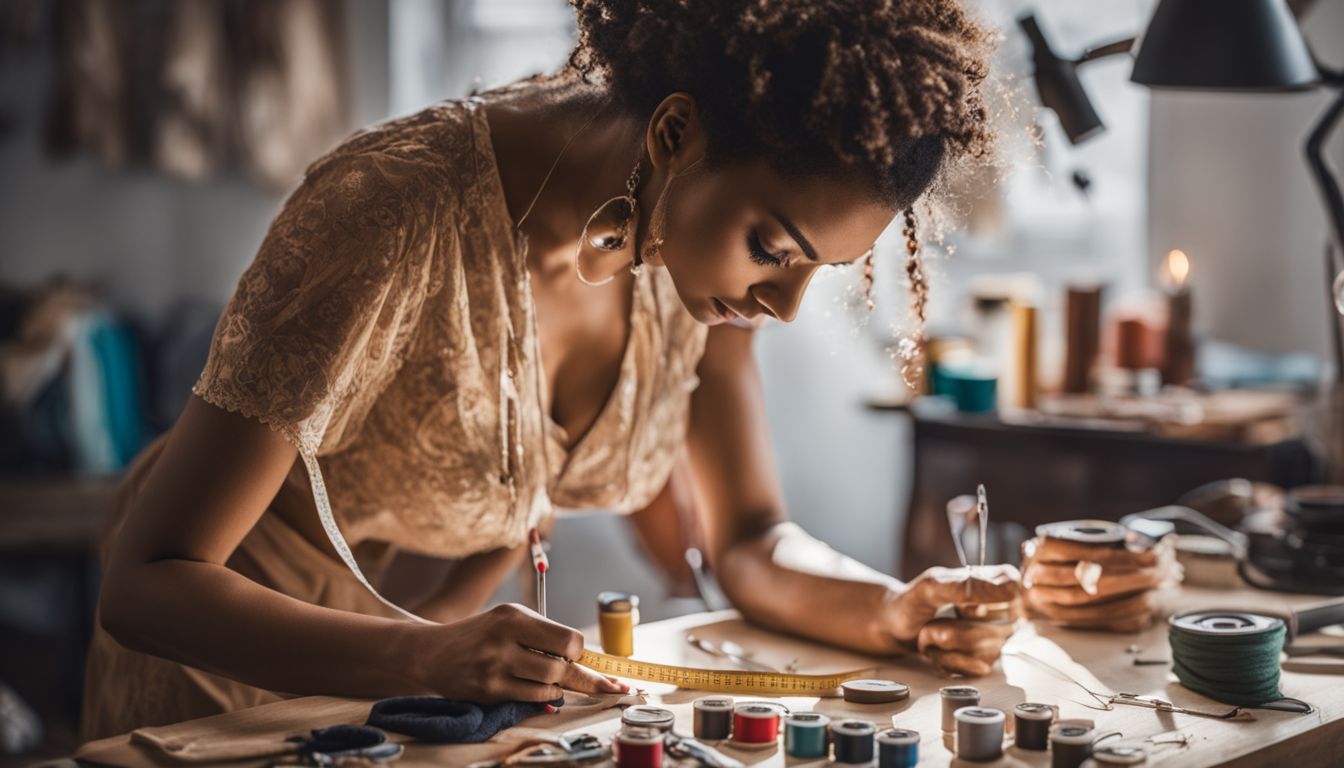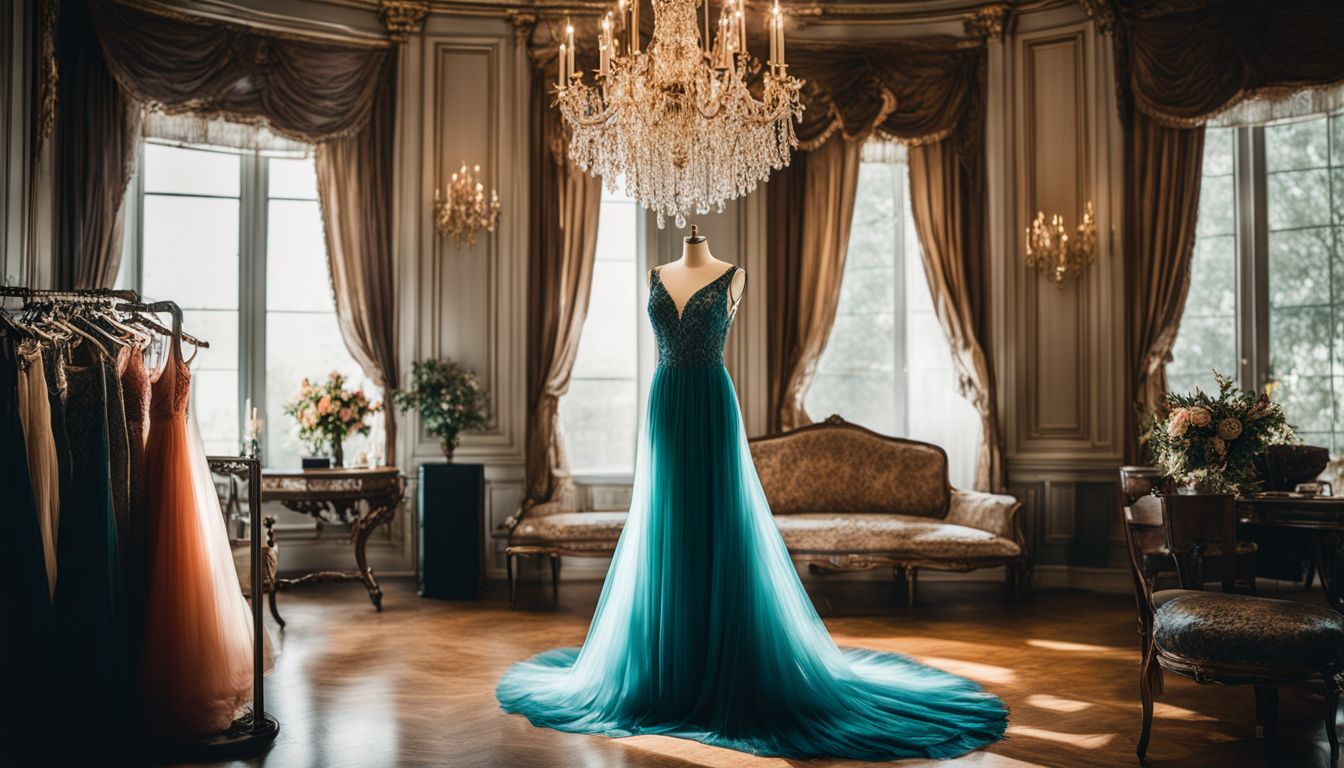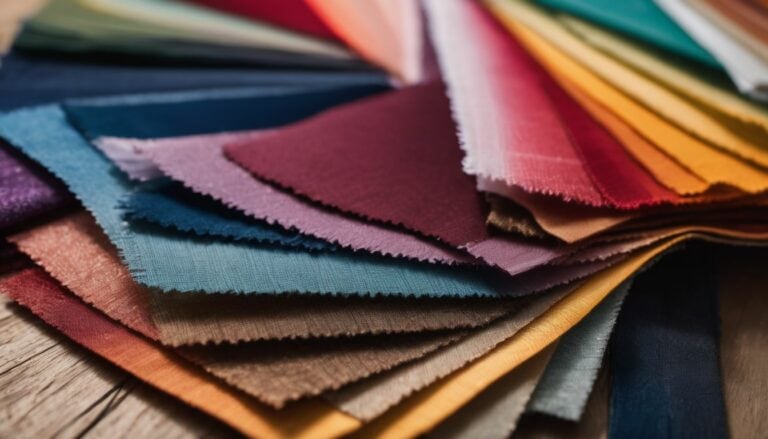Discover the Perfect Amount of Fabric for Your Dress: Expert Tips
Embarking on a dressmaking project can summon a flurry of questions, with the most common being, “How much fabric do I need?” Considering that one yard of fabric roughly equates to 3 feet or 90 centimeters, it’s crucial to calculate accurately.
This comprehensive guide simplifies that process by thoroughly discussing the, perfect amount of fabric for your dress, factors affecting fabric quantity, and providing tips for different dress styles. Let’s dive in and make your next sewing adventure a breeze!
Key Takeaways
- When determining the amount of fabric needed for your dress, consider factors such as the dress style and cut, pattern and design, body measurements, and desired dress length.
- Use a fabric calculator or pattern guide to calculate the yardage of fabric required based on your measurements and selected dress design.
- Remember to factor in seam allowances when calculating fabric yardage to ensure you have enough material for sewing seams together.
- Different dress styles require different amounts of fabric, so consider specific requirements for A-line dresses, ballroom gowns, trumpet/mermaid dresses, and tea-length dresses.
Perfect Amount of Fabric for Your Dress: Factors Determining Fabric Amount

When determining the fabric amount for your dress, it is important to consider factors such as the dress style and cut, pattern and design, body measurements, and desired dress length.
Dress style and cut

The dress style and cut can change how much fabric you need. A simple shift dress may not need a lot of cloth. But a ball gown with many layers will need more. The weight of the fabric matters too.
Heavy cloth falls differently than light cloth. This impacts both look and fit! For a good fit, take right measurements of your bust, waist, and hips too. Using online tools like fabric calculators can make it easier to find out how much fabric is ideal for your dress style and cut.
Pattern and design

The pattern and design of a dress also play a role in determining the amount of fabric needed. Dresses with intricate patterns or large designs may require more fabric to ensure that the pattern is properly aligned and showcased on the garment.
On the other hand, dresses with simple patterns or no specific design elements may require less fabric. It’s important to consider the layout and placement of the pattern on the fabric when calculating yardage.
Additionally, certain dress styles like pleated or gathered skirts may require extra fabric for creating those details in the design. Remember to take these factors into account when determining how much fabric you will need for your dress project.
Body measurements

To determine the perfect amount of fabric for your dress, it’s important to consider your body measurements. This includes accurately measuring your bust, waist, and hips. By knowing these measurements, you can choose the appropriate size and calculate the right amount of fabric needed for your dress.
Taking accurate body measurements ensures that the dress will fit well and that you have enough fabric to create your desired design.
Desired dress length

The desired length of your dress plays a significant role in determining the amount of fabric you’ll need. Whether you want a long, flowing gown or a shorter, tea-length dress, the length will affect how much fabric is required to achieve your desired style.
Longer dresses generally require more fabric, while shorter styles may require less. It’s important to consider this factor when calculating the fabric yardage for your project to ensure that you have enough material to create the perfect dress length you envision.
Calculating Fabric Yardage

Calculate the perfect amount of fabric for your dress using a fabric calculator or pattern guide, making adjustments for pattern repeats and factoring in seam allowances. Don’t miss out on these essential tips!
Using a fabric calculator

To determine the amount of fabric you need for your dress, you can use a fabric calculator. This handy tool helps you calculate the yardage of fabric required based on your measurements and the selected dress design. Here’s how to use a fabric calculator:
- Input your body measurements: Enter your bust, waist, and hip measurements into the fabric calculator. Make sure to measure accurately to get an accurate estimate.
- Select the dress style: Choose the style of dress you want to make from the options provided in the fabric calculator. This could be an A-line dress, ballroom gown, mermaid dress, or any other style.
- Specify the desired dress length: Indicate how long you want your dress to be, whether it’s knee-length, tea-length, or full-length.
- Factor in seam allowances: Seam allowances are extra bits of fabric added to each seam for stitching. The fabric calculator will automatically factor in the standard seam allowance or allow you to input a custom value.
- Calculate yardage: Once you’ve entered all the necessary information, click on the calculate button to obtain an estimate of the fabric yardage needed for your dress.
Using a pattern guide
Determining the right amount of fabric for your dress is easier with a pattern guide. Here’s how to use it:
- Choose a dress pattern that matches your desired style and measurements.
- Look at the back of the pattern envelope or in the instructions booklet for the suggested fabric yardage.
- Find your size on the pattern guide and note the recommended fabric length.
- Consider any adjustments you might need to make based on your body measurements or desired dress length.
- Use this information as a starting point to estimate the fabric yardage needed for your dress.
Making adjustments for pattern repeats

When using a pattern to make a dress, it’s important to consider any pattern repeats. This means that if the fabric has a design or print that repeats, you need to account for this when calculating the fabric yardage. Here are some tips for making adjustments for pattern repeats:
- Identify the pattern repeat: Take a close look at the fabric and determine where the design or print repeats. This will help you understand how much extra fabric you’ll need.
- Measure the distance between repeats: Use a ruler or measuring tape to measure the distance between each repetition of the pattern. This will give you an idea of how much additional fabric is necessary.
- Add extra yardage: Once you know the measurement of the pattern repeat, add this amount to your total fabric yardage calculation. This ensures that you have enough fabric to match up the design and create a cohesive look.
- Consider placement of the pattern: Depending on the style and design of your dress, you may also need to think about where certain parts of the pattern should be placed on different pieces of your garment. Make sure to account for this in your calculations as well.
Factoring in seam allowances

When determining the perfect amount of fabric for your dress, it’s important to factor in seam allowances. Seam allowances are the extra fabric included in the pattern for sewing seams together. Here are some key points to remember when considering seam allowances:
- Seam allowances are typically measured in inches or centimeters and can vary depending on the pattern or personal preference.
- Common seam allowances range from 1/4 inch (0.6 cm) to 5/8 inch (1.6 cm).
- Adding a larger seam allowance gives you more room for adjustments or alterations.
- If you’re using a commercial pattern, the seam allowance is usually specified in the instructions.
- It’s important to measure and mark the seam allowance accurately before cutting your fabric.
- Seam allowances are added to all edges that will be sewn together, including side seams, armholes, necklines, and hems.
Specific Fabric Amounts for Different Dress Styles

Different dress styles require different amounts of fabric. For example, A-line dresses will generally require less fabric than ballroom gowns or trumpet/mermaid dresses. Tea-length dresses will also have specific fabric requirements to consider when determining the perfect amount for your dress.
A-line dresses

A-line dresses are a popular choice for many occasions. These dresses have a fitted bodice that gradually widens towards the hem, resembling the shape of an “A.” When determining how much fabric you need for an A-line dress, consider factors such as your body measurements, desired dress length, and the weight of the fabric.
Taking accurate measurements ensures that you choose the right size pattern and buy enough fabric to accommodate your body shape. The weight of the fabric also affects how the dress drapes and falls on your body.
To estimate fabric yardage for an A-line dress, you can use online calculators or consult a pattern guide to get accurate measurements. Keep in mind any adjustments needed for pattern repeats and don’t forget to factor in seam allowances to ensure there is enough material for your dress project.
Ballroom gowns

Ballroom gowns are elegant and often have a full, flowing skirt. When determining the fabric amount for a ballroom gown, you need to consider its length and style. The longer the dress, the more fabric you will need.
Also, keep in mind that ballroom gowns usually have layers or ruffles, which require extra fabric. It’s important to take accurate measurements to ensure you have enough material for your dress.
Using online fabric calculators can help simplify the process of estimating how much fabric is needed for your ballroom gown.
Trumpet or mermaid dresses

Trumpet or mermaid dresses are known for their fitted bodice and flared skirt that hugs the hips and thighs before flaring out at the knees or lower. These dresses require a significant amount of fabric to create the dramatic silhouette.
When determining the fabric amount for trumpet or mermaid dresses, consider both the length of the dress and your body measurements. The length will determine how much fabric you need, while accurate body measurements will ensure a proper fit.
Keep in mind that these types of dresses often use heavier fabrics to maintain their shape, so choose a fabric with enough weight to support the structure of the dress.
Tea-length dresses
Tea-length dresses are a popular choice for many occasions. They fall between the knee and the ankle, giving a classy and elegant look. When determining the fabric amount for a tea-length dress, it is important to consider the dress style, pattern, body measurements, and desired length.
Tea-length dresses typically require less fabric compared to full-length gowns. You can use a fabric calculator or pattern guide to calculate the exact yardage needed for your specific tea-length dress design.
Taking accurate measurements of your bust, waist, and hips will help ensure you have enough fabric to create a beautifully fitted tea-length dress that flatters your figure.
[Audience]: all
Additional Tips for Fabric Amounts

Create a section that provides additional tips for determining fabric amounts, such as making a wrap dress, dresses for toddlers and girls, pillowcase dresses, and special situations like Cinderella’s dress.
Making a wrap dress
To make a wrap dress, you will need to consider the following:
- Choose a fabric that has a good drape, as it will help the dress wrap nicely around your body.
- Take accurate measurements of your bust, waist, and hips to determine the right size for your wrap dress.
- When calculating fabric yardage, make sure to account for the length of the dress and any pattern repeats in the fabric.
- Don’t forget to add extra fabric for seam allowances and hemming.
- Look for online tutorials or sewing patterns specifically designed for wrap dresses to guide you through the construction process.
Dresses for toddlers and girls
Dresses for toddlers and girls are smaller in size compared to adult dresses. When determining the fabric amount for these dresses, it is important to consider their measurements. You can use a fabric calculator or pattern guide to calculate the required yardage. Remember to factor in seam allowances and any adjustments needed for pattern repeats. Here are some additional tips for fabric amounts when making dresses for toddlers and girls:
- Choose lightweight and comfortable fabrics suitable for children’s clothing.
- For simple straight dresses, estimate around 1 – 1.5 yards of fabric.
- Consider the dress length desired – shorter dresses may require less fabric.
- If making a gathered or full skirt dress, allow for more fabric to create volume.
- Take into account any design elements like ruffles, bows, or pleats that may require extra fabric.
- When making multiple sizes of the same dress, calculate fabric quantities separately for each size.
Pillowcase dresses
- Pillowcase dresses are a popular choice for casual and comfortable wear.
- They are called pillowcase dresses because they can be made from actual pillowcases or fabric that resembles them.
- Pillowcase dresses are usually loose – fitting and flowy, making them ideal for warm weather.
- The amount of fabric needed for a pillowcase dress depends on the desired length and size.
- It is recommended to measure the child’s chest, waist, and length from shoulder to knee to determine the appropriate fabric amount.
- On average, a pillowcase dress may require about 1 yard (or 90 centimeters) of fabric.
- However, larger sizes may need slightly more fabric, while smaller sizes may require less.
- When choosing fabric for a pillowcase dress, lightweight cotton or linen materials are often preferred for their breathability and comfort.
Special situations (e.g., Cinderella’s dress)
Cinderella’s dress is an example of a special situation when determining fabric amounts. Here are some additional tips:
- Cinderella’s dress is typically a full ball gown with a long, flowing skirt. This style requires a significant amount of fabric to create the desired look.
- The length of the skirt in Cinderella’s dress is usually very long, often reaching the floor or even extending beyond it. This means that extra fabric yardage will be needed to achieve the desired dramatic effect.
- The type of fabric chosen for Cinderella’s dress is also important. A lightweight and fluid fabric, such as silk or satin, is often used to create a romantic and ethereal look.
- Embellishments, such as sequins or lace, are frequently added to Cinderella’s dress. When calculating fabric needs for these types of details, it’s important to account for additional yardage.
- Keep in mind that Cinderella’s dress is fictional and can vary depending on the interpretation. Use these tips as a starting point and adjust accordingly based on your specific design choices.
Conclusion

In conclusion, determining the perfect amount of fabric for your dress is crucial for a successful sewing project. By considering factors such as dress style, pattern design, body measurements, and desired length, you can calculate the fabric yardage needed accurately.
Remember to use fabric calculators or pattern guides and make adjustments for any pattern repeats or seam allowances. With these tips in mind, you’ll be able to confidently estimate the right amount of fabric for any dress style and create beautiful garments that fit perfectly.
Happy sewing!
FAQs
1. How do I determine the amount of fabric needed for my dress?
To determine the amount of fabric needed for your dress, you can use a sewing pattern or measure the length and width of each pattern piece and add them together.
2. Can I use any fabric for my dress?
Yes, you can use any fabric for your dress as long as it is suitable for the style and design of the dress. Consider factors such as drape, stretch, and durability when choosing your fabric.
3. What if I don’t have a sewing pattern?
If you don’t have a sewing pattern, you can take measurements of your body or an existing garment that fits well to create a custom pattern. There are also online resources available with free basic patterns that can be adjusted to fit.
4. How much extra fabric should I buy?
It is recommended to buy at least 10-20% more fabric than what is estimated in case there are mistakes or adjustments needed during the cutting and sewing process. This ensures that you have enough material to complete your dress without running short.







